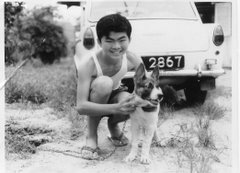At the beginning of 1962 we moved into 7
Sian Tuan Avenue. This was a spacious
house in the Hong Kong Park estate, off Dunearn Road. As a house, there was nothing remarkable about
it, but for a small English boy there were a few novelties. For example, air conditioning in the bedroom
was a new experience. We were renting
the house from a Chinese landlord, and some rooms had large mirrors etched with
Chinese writing. I have no idea what the
writing said.
The land surrounding Hong Kong Park was an
interesting playground for my friends and me.
Immediately opposite was a large area of unused ground, in the centre of
which was an abandoned house. This was a
substantial bungalow, which still had a name on the door – an Indian name – but
after 50 years I don’t remember it. Just
beyond this house was a stream that led to a kampong, surrounded by fields and
grazing cows. It was a surprising rural
scene. The stream itself was of interest
because it was alive with fish. It was
probably alive with a lot of other things too, but we were attracted by the
fish – many of them were guppies (my favourite tropical fish). We had a happy time fishing them out, but
always threw them back because we couldn’t take them home. One day we encountered a big ugly snake that
slid into the water and disappeared, so that was the end of fishing.
At the top of the estate, just past the
bend of Hua Guan Avenue, was another kampong.
This one had a handful of shops where we would spend our pocket money on
dried fish snacks, fireworks and little hand-rolled cigarettes. The shopkeepers didn’t seem to mind what they
sold to us. We made a complete nuisance
of ourselves lighting fireworks and generally annoying the other residents. We were always careful to operate away from
our own homes so that our parents didn’t spot us. The roads around this kampong were dirt
roads, so it was a different world for us.
At the bottom of Sian Tuan Avenue, next to
Dunearn Road, were other “Shack Shops” as we called them, where we could buy
sweets and cigarettes for a few cents. I hope my mother is not reading this!
One place that was completely out of bounds
was the rifle range. But did that stop
us? I’d better stop before I incriminate
myself.
Looking down Sian Tuan Ave, c 1962
My brother in the front garden, c 1962
One feature of Singapore that was totally
alien to us English boys was the monsoon drains. There was a particular time of year when the
drains outside our house filled up with bullfrogs, making the most incredible noise
the whole night through. You could hear
it above the air conditioning.
The other use for the drains, sad to say,
was a dumping ground for unwanted kittens.
More than once we fished out a paper bag with two or three kittens
inside. My mother took them to the RSPCA
where I guess they were put down anyway.
We did once get to keep a kitten, but we couldn’t save all of them.
Finally, at Sian Tuan Avenue, we found out
what it means to live in a war zone.
Well not really, but there were a lot of Chinese families around us, and
Chinese New Year was celebrated with the letting off of firecrackers. We were used to fireworks back in England on
Guy Fawkes night, but there was nothing like the Chinese firecrackers. They were tied in strings, and went off one
after the other like machine guns. Some
strings of firecrackers were several yards long, and went off for several
minutes. Brilliant!
In Singapore, everything changes before
your eyes. The bulldozers arrived and
flattened the ground opposite. Before
long brand new houses appeared and changed the landscape forever.
Earth movers opposite our house in 1963
Our house at 7 Sian Tuan is still there,
largely unchanged. In 2001, almost 40
years later I visited the area, and the main difference was a new canopy over
the front entrance. Looking on Google
street view now, it is much the same except that trees are growing taller and
obscuring the view. The most remarkable
thing is that the original post box is still there, battered and unused.
7 Sian Tuan Ave in 2001
+0011+STC+13+@+Singapore+late+1950s.JPG)










.jpg)
















.JPG)






.JPG)
.JPG)




.jpg)










